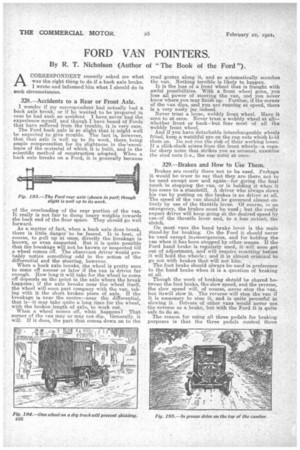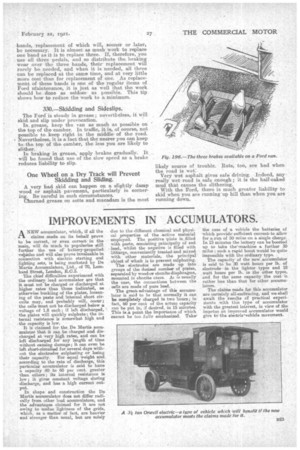FORD VAN POINTERS.
Page 26

Page 27

If you've noticed an error in this article please click here to report it so we can fix it.
By R. T. Nicholson (Author of "The Book of the Ford ").
ACORRESPONDENT recently asked me what was the right thing to do if a ,baek axle broke. I wrote and informed him what I should do in such circumstances.
328.—Accidents to a Rear or Front Axle.
I wonder if my correspondent had actually hada back axle break, or if he wanted to be prepared in case he had such an accident I have never had the experience myself, and though I have heard of Fords that have suffered froin the trouble, it is very rare.
The Ford back axle is so slight that it might well be expected to give trouble. The fact is, however, that that axle is well up to its work, there, being ample compensation for_ its slightness in the texcellence of the material of which it is built, and in the scientific method of construction adopted. When a back axle breaks on a Ford, it is generally because of the overloading of the rear portion of the van. It really is not fair to dump heavy weights towards the back end of the floor space. They should go well forward.
As a matter of fact, when a back axle does break, there is little danger to be feared. It is best, of course, to pull up at once, directly the breakage is. known, or even suspected. But it is quite possible that the breakage will not be known or suspected till a wheel comes off. The observant driver would probably notice something odd in the action of the differential and the steering, however. When a back axle breaks, the wheel is pretty sure to oome off sooner or later if the van is driven far enough. How long it will take for the wheel to come off depends on the point in the axle, where the break happens; if the axle breaks near the wheel itself, the wheel will soon part company with the van, taking with it the short broken piece of axle. If the breakage is near the centre—near the differential, that is—it may take quite a long time for the wheel, with the broken length of axle, to work out. When a wheel comes off, what happens? That corner of the van may or may not dip. Generally. it If it does, the part that comes down on to the road grates along it, and so automatically scotches the van. Nothing terrible is likely to happen. It is the loss of a front wheel that is fraught with awful possibilities. With a front wheel gone, you lose all power of steering the van and you never know where you may finish up. Further, if the corner of the van dips, and you are running at speed, there is a very nasty jars indeed. Never trust a loose, wobbly front wheel. Have it seen to at once. Never trust a, wobbly wheel at all, whether front or back—but fear most of all the wobbly front wheel.
And if you have detachable interchangeable wheels fitted, keep a watchful eye on the cap nuts whieh hold them, on. Do not run the risk of their working loose-. If a click-clack arises from the front wheels—a replar sharp noise that strikes you as unusual, exanbine the stud nuts (i.e., the cap nuts) at once.
329.—Brakes and How to Use Them.
Brakes are mostly there not to be used. Perhaps it would be truer to say that they are there not to be used except now and again—for giving the final touch in stopping the van or in holding it when it has come to a standstill. A. driver who always slows his van by putting on tho brakes is no driver at all. The speed of the van should be governed almost entirely by use of the throttle lever. Of course, in an emergency, the brakes must be used ; but the -really expert driver will keep going it the desired speed by usesaf the throttle lever and, to a less extents the clutch.
On most vans the hand brake lever is the main stand-by for braking. On the Ford it should never be used except inomergencies, and for holding the v-an when it has been stopped by other means. If the Ford hand brake is regularly used, it will soon get out of adjustment, and will require resetting before it will 'hold the wheels; and it is almost criminal to go out with brakes that will not bite.
The foot brake should always be used in preference to the hand brake when it is a questionof braking at all.
• Though the work of braking shduld be shared between the foot brake, the slow speed, and the reverse, the slow speed will, of course, 'never stop the van, but itovvill slow it. The reverse will stop the van if it is necessary to step it, and is quite powerful in slowing it. Drivers of other vans would never use the reverse as a brake, but with the Ford it is quite safe to do so.
The reason for using all three pedals for braking purposes is that the three pedals control three
-bands, replacement of which will, sooner or later, be necessary. It is almost as much work to replace one band as it is to replace three. If, therefore, you use all three pedals, and so distribute the, braking wear over the three bands, their replacement will rarely be needed, and when it is needed, all three can be replaced at the same time, and at very little more cost than for replacement of one. As replacement of these bands is one of the regular items of Ford niaintenance, it is just as well that the work should be done as seldom as possible. This tip shows how to reduce the work to a minimum.
330.—Skidding and Sideslips.
The Ford. is steady in grease; nevertheless, it will skid and slip under provocation. In. grease, keep the van as much as possible on the top of the camber. In traffic, it is, of course, not possible to keep right in the middle of the road. Nevertheless it is a fact that the nearer you can keep to, the top of the camber, the less you are likely to slither.
In braking in grease, apply brakes, gradually. It will be found that use of the slow speed as a brake reduces liability to slip.
One Wheel on a Dry Track will Prevent Skidding and Sliding.
A very bad. skid can. happen on a slightly damp wood or asphalt pavement, particularly in cornering. Be careful in such circumstances. Churned grease on setts and macadam is the most likely source of trouble. Ruts, the road is wet:. too, are bad when Very wet asphalt gives safe driving. Indeed, any • really wet road is safe enough; it is the half-caked mud that causes the slithering.
With the Ford, there is much greater liability to skid when you are running up hill than when you are running down.






























